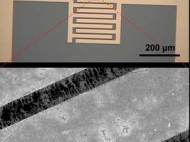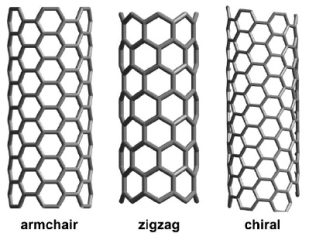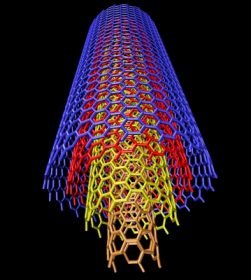Nanotechnologies – Carbon nanotubes
 The discovery of nanotubes remains a debatable issue, especially because several scientists involved in the research could be likely candidates for the Nobel Prize. A large percentage of academic and popular literature attributes the discovery of hollow, nanometer-size tubes composed of graphitic carbon to Sumio Iijima of NEC in 1991. Carbon nanotubes have been produced and observed under a variety of conditions prior to 1991 by various scientists ever since 1952 in Soviet Union.Fullerenes and carbon nanotubes are not necessarily products of high-tech laboratories; they are commonly formed in such everyday processes such as ordinary flames, produced by burning methane, ethylene, and benzene. Furthermore they have been found in soot from both indoor and outdoor air. However, naturally produced nanotubes can be highly irregular in size and quality because of the uncontrolled environment in which they are produced.
The discovery of nanotubes remains a debatable issue, especially because several scientists involved in the research could be likely candidates for the Nobel Prize. A large percentage of academic and popular literature attributes the discovery of hollow, nanometer-size tubes composed of graphitic carbon to Sumio Iijima of NEC in 1991. Carbon nanotubes have been produced and observed under a variety of conditions prior to 1991 by various scientists ever since 1952 in Soviet Union.Fullerenes and carbon nanotubes are not necessarily products of high-tech laboratories; they are commonly formed in such everyday processes such as ordinary flames, produced by burning methane, ethylene, and benzene. Furthermore they have been found in soot from both indoor and outdoor air. However, naturally produced nanotubes can be highly irregular in size and quality because of the uncontrolled environment in which they are produced.
There are many different techniques which are used to produce nanotubes in sizeable quantities. Among most accepted are arc discharge, laser ablation, high pressure carbon monoxide (HiPCO), and chemical vapor deposition (CVD). Most of these processes take place in vacuum or with process gases. CVD growth of carbon naotubes can occur in vacuum or at atmospheric pressure. Advances in catalysis and continuous growth processes are making carbon nanotubes more commercially viable.
Carbon nanotubes (CNTs) are allotropes of carbon with a nanostructure that can have a length-to-diameter ratio of up to 28,000,000:1, which is considerably larger than any other material. These cylindrical carbon molecules have novel properties that make them potentially useful in many applications in nanotechnology, electronics, optics and other fields of materials science, as well as potential uses in architectural fields. They exhibit extraordinary strength and unique electrical properties, and are efficient conductors of heat. Their final usage, however, may be limited by their potential toxicity.
A study named “Direct imaging of single-walled carbon nanotubes in cells” led by Alexandra Porter from the University of Cambridge shows that CNTs can enter human cells and accumulate in the cytoplasm, causing cell death.
A group of other studies collectively show that regardless of the process by which CNTs were synthesized and the types and amounts of metals they contained, CNTs were capable of producing inflammation, microscopic nodules, fibrosis, and biochemical/toxicological changes in the lungs.
The needle-like fiber shape of CNTs, similar to asbestos fibers, raises fears that widespread use of carbon nanotubes may lead to cancer of the lining of the lungs often caused by exposure to asbestos.
Despite those facts researchers invest a lot of their resources into the development of technologies which rely on nanotubes. The technology is used in many applications such as nanotechnology, electronics, optics and other fields of materials science, as well as potential uses in architectural fields.
Single-walled nanotubes (SWNT) roughly have a 1 nanometer diameter, with a tube length that can be up to 28 million times longer. The structure of a SWNT can be conceptualized by wrapping a one-atom-thick layer of graphite called graphene into a seamless cylinder. Depending on their structure the SWNT are named zigzag, armchair, graphene nanoribbon or chiral. SWNT are an important variety of carbon nanotube because they exhibit electric properties that are not shared by the multi-walled carbon nanotube (MWNT) variants. Single-walled nanotubes are the most likely candidate for miniaturizing electronics beyond the micro electromechanical scale currently used in electronics. The most basic building block of these systems is the electric wire, and SWNTs can be excellent conductors. One useful application of SWNTs is in the development of the first intramolecular field effect transistors (FET).Multi-walled nanotubes (MWNT) consist of concentric tubes of graphite. There are two models which can be used to describe the structures of multi-walled nanotubes – the Russian Doll model and the Parchment model. In the Russian Doll model, sheets of graphite are arranged in concentric cylinders while in the Parchment model, a single sheet of graphite is rolled in around itself, like a scroll of parchment or a rolled newspaper.
The double-walled carbon nanotubes (DWNT) are widely used because of their morphology and properties. DWNTs are similar to SWNT but their resistance to chemicals is significantly improved. This is especially important when chemical functions are added to the surface of the nanotubes thus adding new properties to the CNT.
A nanotorus is a theoretically described carbon nanotube bent into a torus. Nanotori are predicted to have many unique properties, such as magnetic moments 1000 times larger than previously expected.
Carbon nanobuds are a newly created material combining two previously discovered allotropes of carbon; carbon nanotubes and fullerenes. In composite materials, the attached fullerene molecules may function as molecular anchors or bonds. By this means, carbon nanobds could be used to prevent the slipping of the nanotubes or to connect them as in a manner similar to building blocks. thus improving the composite’s mechanical properties.
The strength and flexibility of carbon nanotubes makes them of potential use in controlling other nanoscale structures, which suggests they will have an important role in nanotechnology engineering.
Comparing to other contemporary technologies which are close to their permeation, nanotubes are still relatively expensive to produce. However, the market of nanotubes keeps on growing and the prices are more acceptable.
Many applications of this technology are going to be reviewed in our future articles.











That’s a smart answer to a dffiilcut question.